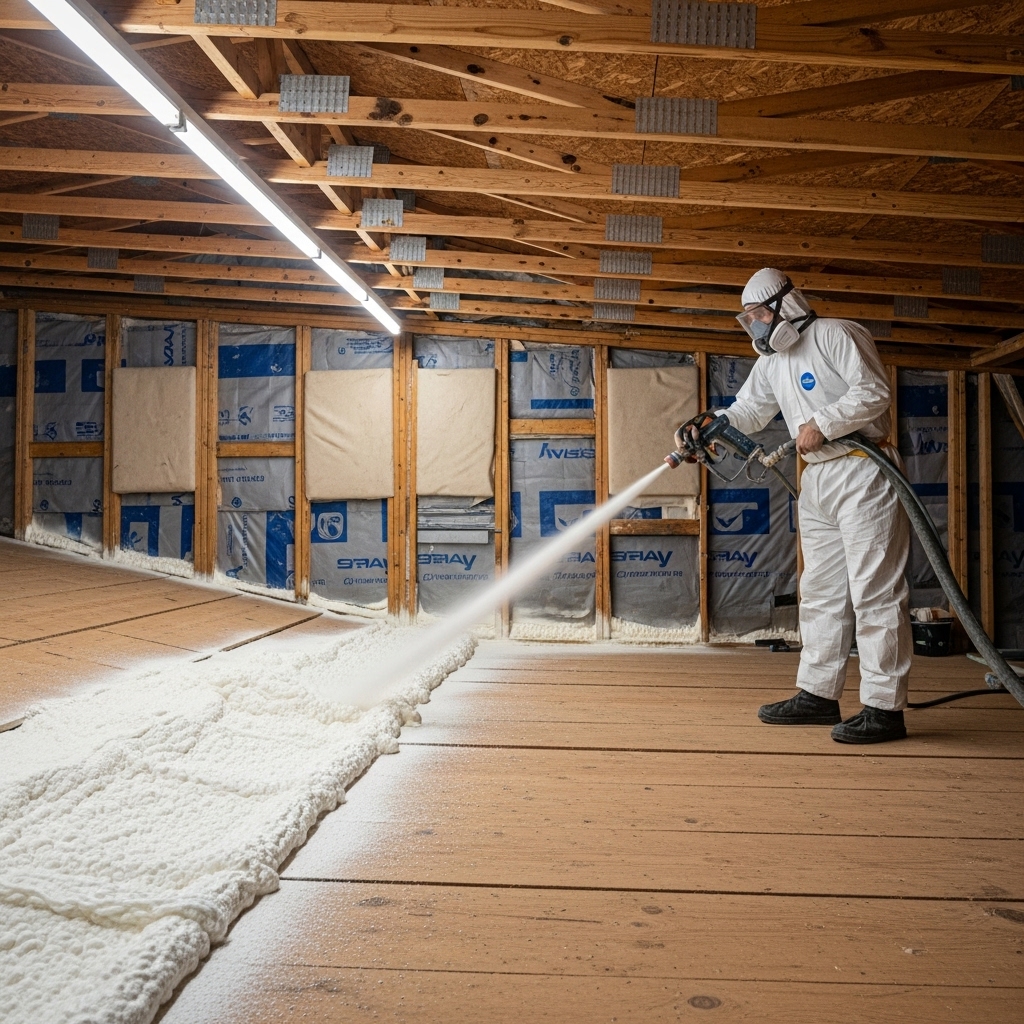Spray foam insulation is one of those upgrades that rewrites the way a Los Angeles home behaves, especially when it is applied with a strategy that respects our climate and your building’s architecture. It does more than resist heat flow; it also creates an air barrier that calms drafts and steadies indoor conditions through our long, sun-soaked summers and cool, breezy nights. Because every home, from a canyon-side midcentury to a coastal contemporary, presents different needs, the first step is understanding how spray foam fits into your attic or wall assembly. If you are browsing options and want a clear reference for best practices, you can study local examples of insulation installation to see how planning influences results.
Why Spray Foam Appeals to Los Angeles Homeowners
In a region where cooling can dominate for much of the year, controlling air movement is just as important as adding thermal resistance. Spray foam’s ability to expand into cracks, adhere to surfaces, and form a continuous air seal makes it uniquely effective in assemblies that are hard to reach or seal with conventional materials. When a roof deck is foamed, the attic can be brought closer to indoor conditions, which stabilizes ductwork performance and reduces radiant heat cascading into rooms below.
Another draw is comfort. Foam dampens street noise, blunts hot spots, and keeps rooms from feeling parched on windy days. For homeowners near busy corridors or under flight paths, reducing noise through the roof deck or exterior walls can be as compelling as the thermal benefits. These improvements are not cosmetic; they transform how your home feels and functions day to day.
Open-Cell and Closed-Cell: Different Tools for Different Jobs
Open-cell foam is lighter and slightly softer, expanding generously to fill voids and help with sound control. Closed-cell foam is denser and adds rigidity to the assembly while providing exceptional air sealing in a thinner layer. In Los Angeles, the choice depends on the assembly you are working with and your priorities for air tightness, roof deck interaction, and sound attenuation. Both types require professional application and thoughtful planning to integrate safely with ventilation and fire protection measures.
Homes with intricate rooflines, dormers, or partial vaulted ceilings can benefit from the way foam knits together complex shapes. Where batts or blown-in material might struggle to maintain contact or continuity, foam adheres to the substrate and creates an even surface that resists air movement. That integrity is what many homeowners feel as a quieter, steadier home after the project is complete.
Designing the Assembly: Roof-Deck Foam vs. Ceiling-Plane Strategies
One major decision is where to establish your thermal and air boundary. With roof-deck foam, you bring the attic closer to indoor conditions and largely eliminate wind-washing of insulation at the eaves. Ducts and equipment within that attic then operate in a friendlier environment. Alternatively, you can preserve a vented attic and focus on air sealing and insulating the ceiling plane. Each strategy has strengths, and the right choice often hinges on access, roof geometry, and how you plan to maintain ventilation and moisture control.
For Los Angeles homes, the roof-deck approach can be appealing in remodels where ceiling-plane air sealing is challenging or when the attic houses sensitive mechanicals. A vented attic with a perfected ceiling plane shines in homes with clear access and simple rooflines. The common denominator is detail: baffles where they belong, safe clearances, and a continuous air barrier wherever you draw the line between indoors and out.
Moisture Behavior in Our Climate
Despite our reputation for dry weather, moisture still moves through structures with daily temperature swings and coastal influence. Spray foam, particularly closed-cell, can act as a moisture retarder in the right configuration. What matters most is that the entire system is designed to let assemblies dry to the appropriate side and that ventilation supports the chosen strategy. Bath fans must vent outdoors, and roof assemblies should avoid trapping moisture through conflicting layers.
Real-world practice favors simplicity. If you create a conditioned attic, you minimize pathways for humid indoor air to rise into a cold surface in winter. If you keep a vented attic, make sure the air pathway is uninterrupted and that insulation remains neatly out of the airflow at the eaves. Either pathway, done well, delivers comfort and resilience.
Fire Safety, Ignition Barriers, and Inspections
Spray foam requires attention to fire safety. Assemblies may call for ignition or thermal barriers depending on the location and how the space is used. An experienced installer will explain how the foam will be protected, where barriers are required, and how the details meet code. Inspection readiness is part of the craft, and a tidy, well-labeled job with documentation positions your project to move smoothly through approvals.
These steps are not just regulatory. They protect the longevity and safety of your home. A professional crew welcomes questions about these measures, shows product data, and points to similar jobs they have completed in Los Angeles neighborhoods like yours.
Installation Conditions and Quality Control
Foam quality depends on preparation, temperature, and mixing ratios. Professional crews condition the space, monitor substrate temperatures, and verify that equipment is delivering consistent material. They work in passes that build up to the specified depth, trim when necessary, and keep a photographic record of coverage in areas that will be concealed later. Clean lines at transitions, clear identification of protected penetrations, and safe distances from heat sources show up in the finished work.
Just as important is how the crew treats your home. Careful staging, protection of pathways, and daily cleanup make the process manageable even in occupied homes. Communication about when areas will be inaccessible and how ventilation will be handled during and after application ensures a predictable, low-stress experience.
When Spray Foam Shines in Retrofits
Retrofits rarely offer the blank canvas of new construction. Attics can be tight and layered with decades of modifications. Spray foam earns its reputation in these settings by conquering irregular shapes, sealing stubborn gaps, and stabilizing assemblies that have been patched repeatedly. In homes with vaulted ceilings, foam can reestablish continuity where other materials struggle to connect. The result is a home that feels renewed from the top down.
If your ducts live in a scorching attic or your upstairs refuses to stay cool on summer evenings, foam at the roof deck can make a tangible difference. By moving the thermal boundary outward and calming air movement, it shields the rooms below from the attic’s extremes and gives your mechanical system a kinder environment in which to work.
Sound Control and Everyday Peace
Los Angeles is lively, and many homes sit close to busier streets, schools, or commercial corridors. Foam’s ability to reduce air pathways also reduces the routes sound uses to enter a home. While not a substitute for dedicated acoustic assemblies, the improved continuity and mass often make interiors feel more tranquil, especially in rooms directly under the roof.
For homeowners under flight paths or near freeways, a comprehensive strategy pairs foam with careful sealing around penetrations, attention to window performance, and smart interior finishes. The goal is a cohesive interior environment where outdoor noise feels distant and daily life feels calmer.
Coordination with HVAC and Ventilation
Foam changes the way your home exchanges air with the outdoors, which is why coordination with HVAC matters. If you create a conditioned attic, you may also improve duct performance and reduce leakage losses. In some cases, updating or right-sizing equipment becomes part of the conversation. Bath fans should be verified for proper operation and venting, and if your home includes whole-house ventilation, it should be balanced to the new, tighter envelope.
The best projects treat insulation and mechanical systems as partners. When both are tuned, you get even temperatures, healthy air, and a home that runs quietly and efficiently throughout the year.
From Assessment to Walkthrough: What to Expect
The process begins with a careful look at the spaces to be foamed, identification of air pathways, and a plan for ventilation and fire protection. If removal or cleaning is required, it is completed first. Application follows, with pauses for inspection of coverage and adherence to the plan. After curing and any necessary trimming, protective barriers are installed, and the crew conducts a final review to confirm safe clearances and clean access routes.
The walkthrough should feel like a guided tour of your home’s new envelope. You’ll see how complex transitions were handled, where barriers were added, and how the assembly will age gracefully with normal maintenance. Documentation provides a record for future work and peace of mind that the job was performed to a high standard.
Frequently Asked Questions
Is spray foam safe for my family?
When applied by trained professionals following established protocols, spray foam is a durable component of many assemblies. The crew manages ventilation during application and allows the material to cure before closing the space. Afterward, the foam is inert. Fire protection measures and inspection-ready details complete the safety picture.
Should I choose open-cell or closed-cell foam?
It depends on your goals and the assembly. Open-cell is excellent for filling complex shapes and dampening sound, while closed-cell excels where a denser, more rigid layer is beneficial. Your installer will recommend a type based on the location, moisture dynamics, and desired performance.
Will spray foam make my home too tight?
Foam improves air tightness, which is good for comfort and energy use. The key is balancing that tightness with appropriate ventilation. Your contractor should discuss bath fan performance, fresh-air strategies if needed, and how your HVAC system will work with the new envelope.
Can spray foam be used in older Los Angeles homes?
Yes, provided the plan respects existing materials and wiring and includes proper ventilation and fire safety. Foam often shines in retrofits because it can adapt to unusual framing and reach places other materials cannot. A careful assessment ensures that the assembly remains durable and able to dry appropriately.
What happens to ducts if I foam the roof deck?
Ducts benefit from the milder conditions of a conditioned attic. They are less exposed to extreme heat, which stabilizes supply temperatures and reduces the burden on your equipment. Sealing and insulating ducts remain good practice, but the environment around them becomes much friendlier.
How long does the process take?
Project duration varies with access, preparation, and the size of the area being foamed. Your crew will outline the schedule, including any times when spaces will be temporarily inaccessible and when final inspections will occur. Clear communication keeps the project predictable from start to finish.
If you are ready to explore whether foam fits your home, start with a conversation that respects your goals and your building’s unique story. Look to local teams that emphasize planning, documentation, and careful execution. To see how a disciplined approach unfolds in practice, review proven methods for insulation installation and then schedule a visit. A well-designed project trades hot, noisy rooms for a steady, quiet home that feels right in every season.

